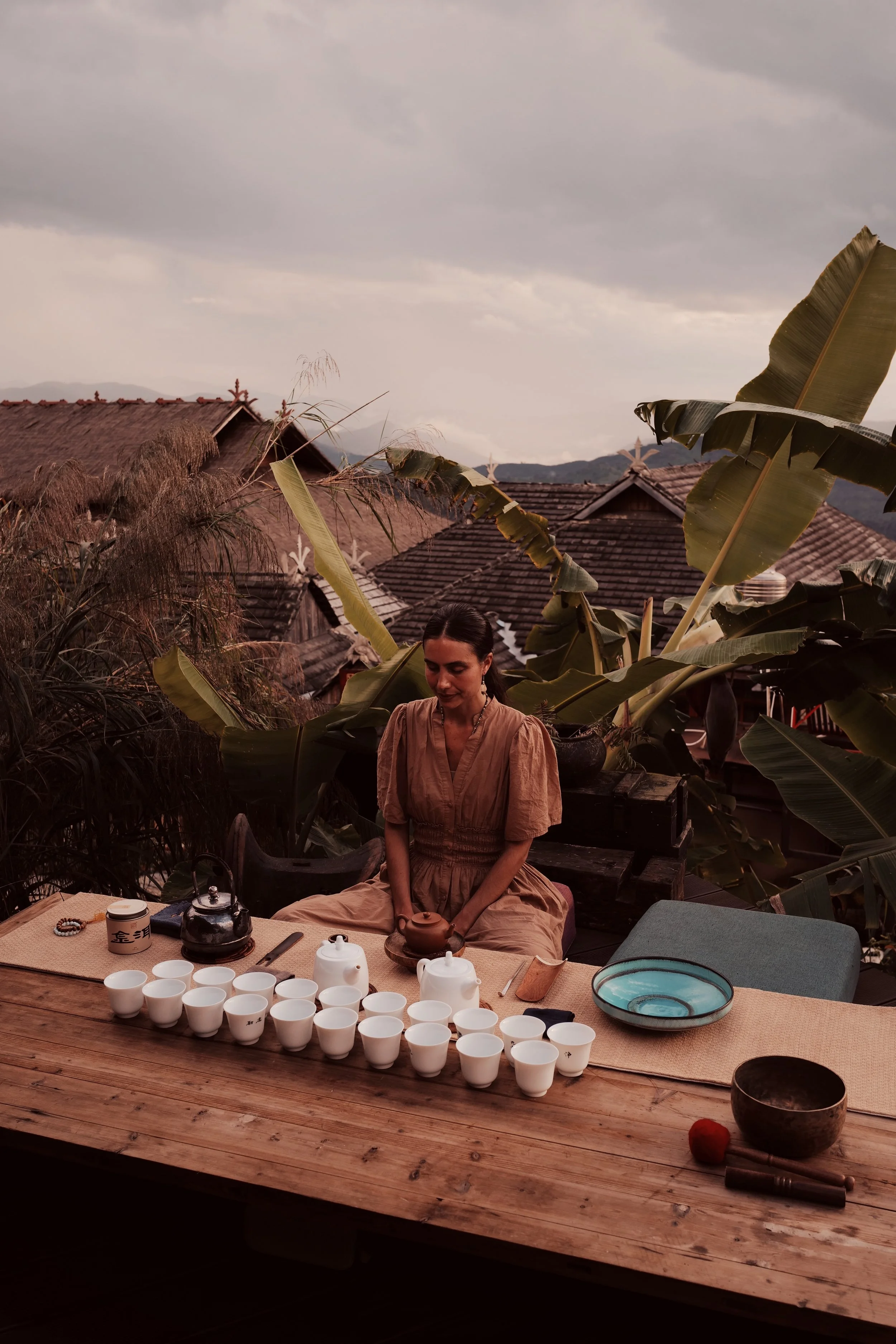
How to explore Chapter 6
For this chapter, there is no audio theory. The chapter will be shared through different videos and supporting written texts. Finally there will be questions proposed to you, to explore where you are in your tea journey. Our tea for this chapter is a pu’er (Earth element tea).
Cultivating your tea practice and creating your offering
For this chapter, we will be exploring the process of creating your offering and we will share a tea meditation. Many of you may already have a practice, an offering where you are called to hold space for others. You may feel inspired to weave the ritual of tea into an offering that you already share with your community. I have been often asked to bring the practice of tea meditation to many types of environment : long or short retreats, festivals, shows, corporate workshops, commemoration events, baby blessings, marriage, or celebration of any life transition. The ritual of tea can be shared for different types of occasion. Therefore, the creation of the ritual will be varying, depending on the people invited to receive tea. The form and style of the ritual, the decoration of the chaxi, the tea ware and tools being used, and the way the ritual is being communicating while sharing — will have to be mindfully decided, to synchronize with the intention of the offering and the guests attending.
For the tea offering shared in this chapter, I am using a side handle steeping vessel, to steep my Pu’er cha. The side handle vessel originated in China, around the Song dynasty, initially used to boil the leaves directly in it, or as a kettle to boil the water. The side handle vessel, or Yokode Kyusu, is also used in modern Japan as a steeping vessel, sometimes for Senchado or for more casual tea practices. After boiling the leaves in the side-handle vessel, I am pouring my tea into bowls, and would typically share three bowls along the journey of this tea meditation : 1 bowl for the essence, 1 bowl for the Qi and 1 bowl for the spirit.
Here is a list of the items, vessels and tools that I use for this form of Tea Meditation, with the respective elements carried by each items :
Water and Leaves (Water + Wood elements)
Clay kettle and source of heat, to boil my water (Earth + Fire elements)
Wood scoop, to present my dried leaves (Wood element)
Side handle vessel, to infuse water and leaves (Earth element)
Tea bowls, to receive the tea (Earth element)
Hand woven chabu + bamboo tea runner, for my chaxi (Wood element)
Piece of wood, to elevate my brewing vessel (Wood element)
Vase with fresh flowers (Earth + Wood element)
Water waste container, for your rinse (Metal element)
Rattan coasters, for the cups and kettle (Wood element)
Tea stones (Metal element)
Tea cloth (Wood element)
Tea Meditation demonstration :
with a side-handle teapot for steeping the leaves, and tea bowls for serving and receiving

Tea Exploration
To explore this guided tea meditation, you are invited to get yourself some hot water, tea leaves and any vessels of your preference. We will be exploring the way of tea through a guided meditation, and share 3 bowls of tea.
Once you are done exploring this tea meditation, I invite you to get a journal, and explore the following questions :
What are you learning from the way of tea?
How would you describe your relationship with the plant Camellia Sinensis?
What is this plant representing for you?
What have you learned from this plant teacher, since the beginning of your journey?
Which form of tea ritual is resonating the most with you?
To what types of tea are you most drawn to?
Are you feeling inspired to dedicate time everyday to your tea practice?
If you have a tea practice, how is it beneficial for you in your life?
TEA COURSE PACKAGE
If you are supporting your practice with the tea course package, for this chapter, we explore either New Earth Shu Pu’er or Zuowang Shu Pu’er, both from wild indigenous trees of the region of Menghai, Yunnan, China. The leaves of New Earth Shu Pu’er were harvested in 2018 and the leaves of Zuowang Shu Pu’er were harvested in 2007.
Both are carrying the deep nourishing wisdom of the Earth element, an invitation for introspection, meditation, absorption, presence.
The Way of Tea Course
CONTENT
Chapter 1
The story of Tea
Chapter 2
Theory of Chapter 2
Chapter 3
Theory of Chapter 3
Chapter 4
Gong Fu Cha Theory
Chapter 5
Theory of Japanese Tea History
Chapter 6
Creating your Tea Offering
Chapter 7
Ritual beyond the Ritual




